| Srl | Item |
| 1 |
ID:
161237
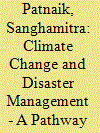

|
|
|
|
|
| Summary/Abstract |
While Climate change is perceived as global problem India is no exception to it. Nearly 700 million people in rural India are directly depending for their livelihood on climate-sensitive sectors such as agriculture, forests, fisheries and natural resources. Climate change has a strong impact on all the natural ecosystems, health and socio-economic systems, as reported by India to the United Nations Framework Convention on Climate Change (UNFCCC).
|
|
|
|
|
|
|
|
|
|
|
|
|
|
|
|
| 2 |
ID:
145917
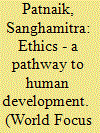

|
|
|
|
|
| Summary/Abstract |
Human Development revolves around three key words – capability, growth and participation. It believes in widening human capabilities through the development of human resources. It also implies that the benefits of growth must be translated into the lives of people. It emphasizes that people must be able to participate actively in influencing the processes that shape their lives. Thus, participation of the people in the decision-making process ensures empowerment and growth. Power according to Gandhiji gets expanded when it is shared with others. The base of his ethics of power is very much dependent on who exercises it. Here, power is derived from the people and should be used for people’s welfare.
|
|
|
|
|
|
|
|
|
|
|
|
|
|
|
|
| 3 |
ID:
136841
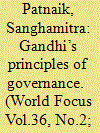

|
|
|
|
|
| Summary/Abstract |
Ethics of Gandhian good governance stands the test of time for its universal character. Individual should think about the common interests and misery instead of concentrating on his own selfish interest. He makes the individual to discover truth by thinking of his neighbor, who represents humanity in miniature.
|
|
|
|
|
|
|
|
|
|
|
|
|
|
|
|
| 4 |
ID:
130823
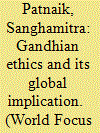

|
|
|
|
|
| Publication |
2014.
|
| Summary/Abstract |
Politics is the most crucial human activity that involves governance. Ethics is the set of principles those regulate the activity of governance and administration. Before we focus on Gandhian Ethics it is necessary to focus on the two schools of thought - Idealism and Realism. Idealism was an approach to international politics based upon liberal assumptions and principles. lt was optimistic as it envisioned a world.in which law, institutions and diplomacy replaced power, competition and use of force. This School was represented 'by St. Simon, Richard Cobden. Aldous Huxley, Russell, Mahatma Gandhi, Wilson and Margaret Mead. It gave emphasis on the role of education and international institutions to bring a better world. It focused on the Positive side of human nature. It proceeded with the assumption that the harmony of the interests was not impossible. Hans J. Morgenthau is the main exponent of realist theory. For him the central focus of realism was power. He de?ned power as "man's control over the minds and actions of other man"(Morgenthau,l993). He emphasized on: lnevitability of conflict among nations, Centrality of Power, Ever -present threat of war.
|
|
|
|
|
|
|
|
|
|
|
|
|
|
|
|
| 5 |
ID:
143995
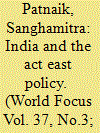

|
|
|
|
|
| Summary/Abstract |
India enjoys a long history of trade and culture exchange with East Asia which started from 1st millennium B.C. when Silk Road and Calicut emerged as major trading port in South Asia. The cultural bond was initiated with the spread of Buddhism during the period of Ashoka the Great.
|
|
|
|
|
|
|
|
|
|
|
|
|
|
|
|
| 6 |
ID:
142137
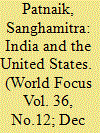

|
|
|
|
|
| Summary/Abstract |
US President Barack Obama defined Indo-US relations as “one of its most important relationships in an uncertain world”. According to J. Tellis, Senior Associate at the Carnegie Endowment for International Peace, Washington D.C., in the backdrop of damage caused by the Khobragade affair, he hoped that both India and United States “will not forget that the special courtesies extended to one another reflects their desire for a stronger strategic bond and hence must not be measured by any picayune notions of mechanistic reciprocity. President Barack Obama is the first U.S. President to visit India twice during office, and is also the first U.S. President to be the chief guest at the Republic Day. ‘Shared Effort; Progress for All’ added a new dimension to Indian foreign policy towards the United States. It envisioned the extensive bilateral strategic and global partnership between the two countries. The pledge of these two major democracies of the world to carry forward their partnership across the spectrum of human endeavor to better their citizens’ lives and that of the global community will certainly set the stage for world peace and security.
|
|
|
|
|
|
|
|
|
|
|
|
|
|
|
|
| 7 |
ID:
141598
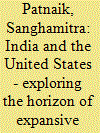

|
|
|
|
|
| Summary/Abstract |
The Indo- US relations represent a new landmark in the changed international scenario. They are the proud fore- runners of the two most populous democracies of the world. The determined effort of the US administration to assist in India’s rise as a major power has significant implications for US interests in Asia in general and South Asia in particular. The collapse of the Soviet Union had changed the balance of power. Every country including India is looking for an appropriate place in this changed scenario. The Indo – US partnership that had made a new beginning during the latter part of the Clinton Administration that reached a new high to build up new security architecture in Asia. The 2005 US-India agreement showed their resolve to establish a “global partnership” through increased cooperation on various issues. It is interesting to analyze the dynamics of Indo-US relations under a new government led by the Indian Prime Minister Narendra Modi.
|
|
|
|
|
|
|
|
|
|
|
|
|
|
|
|
| 8 |
ID:
151127
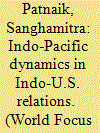

|
|
|
|
|
| Summary/Abstract |
The shift in global economic power from the West to East and the evolving geostrategic importance of the Indo-Pacific region has added new dynamics in Indo-U.S. relations. It paves the way for both cooperation and competition among the so called established and emerging powers in the region. While there is economic convergence, the geostrategic uncertainties make the whole region full of challenges and opportunities as well. The US rebalance, conflict and cooperation in the Indo-Pacific and non-traditional threats in the region are of great implications for Indo-U.S. relations. The United States has been deeply engaged in the region – militarily, economically, and diplomatically during World War II and throughout the Cold War.
|
|
|
|
|
|
|
|
|
|
|
|
|
|
|
|
| 9 |
ID:
143051
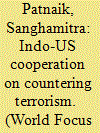

|
|
|
|
|
| Summary/Abstract |
The Indo-US cooperation on countering terrorism can reinvigorate their relationship if both the countries understand the sensitivity of the issue from each other’s point of view and act accordingly. This is a challenge from the non-state actors with global membership. It can only be tackled with collaborative efforts on the part of both United States and India- the largest and oldest democracies of the world.
|
|
|
|
|
|
|
|
|
|
|
|
|
|
|
|
| 10 |
ID:
116089
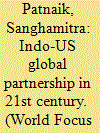

|
|
|
| 11 |
ID:
150601


|
|
|
|
|
| Summary/Abstract |
The global security system is very much endangered by a new challenge from non-state actors like ISIS with membership from different countries. The post-9/11 world compelled United States of America to review its security system. The US counterterrorism efforts in the Af-Pak region and the terror attacks on Indian cities brought India and the US to join hands to work out strategies for countering terrorism. The need of the hour is to build up confidence and trust in each other and readjust their perspectives on the threat of terrorism by understanding various causes of the development of religious radicalism.
|
|
|
|
|
|
|
|
|
|
|
|
|
|
|
|
| 12 |
ID:
147984
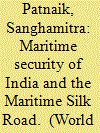

|
|
|
|
|
| Summary/Abstract |
The rise of China in Asia’s maritime security architecture is playing a determinant factor for India to define its strategic interests and review its maritime policy. For the first time Indian government document formally acknowledged the implications of the evolving and increasingly accepted concept of the “Indo-Pacific” on India’s maritime security. The geographic extent of this concept with its multiple variations essentially brings the Indian Ocean and the Western Pacific — theaters of geo-political competition — into one strategic arc.
|
|
|
|
|
|
|
|
|
|
|
|
|
|
|
|
| 13 |
ID:
144009
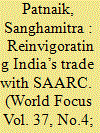

|
|
|
|
|
| Summary/Abstract |
The South Asian Free Trade Agreement (SAFTA) commenced in 2006, envisaging a duty free area by 2016 for all Member Countries. However, the success achieved under the treaty has been quite limited; intra-SAARC trade has continued to be around 4 percent of the total trade of the region. It has been argued that one of the reasons for SAFTA being ineffective is because of the large Sensitive (sometimes called negative) Lists maintained by Member Countries; such items are not offered concessional tariffs.
|
|
|
|
|
|
|
|
|
|
|
|
|
|
|
|